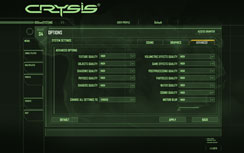Crysis
Publisher: Electronic ArtsWhat can we say about this game that hasn’t been said already? Crysis is probably the most anticipated game on the PC last year and was released on November 16th 2007.
Crysis is seen by many as the poster boy for DirectX 10 and it will make your system cry, quite literally – it’s a monster! It doesn’t come as much of a surprise then, that the graphics are something special – they’re above and beyond anything we’ve ever seen in a PC game.
We tested the game under both DirectX 9.0 and DirectX 10 with the 1.1 patch applied. We used a custom timedemo recorded on the Island map which is more representative of gameplay than the built-in benchmark that renders things much faster than you’re going to experience in game. We found that around 25-30 fps in our timedemo was sufficient enough to obtain a playable frame rate through the game. It’s a little different to other games in that the low frame rates still appear to be quite smooth.
For our testing under DirectX 9.0, we set all of the in-game settings to high, while we set shader quality and water quality to 'very high' for DirectX 10 -- all other settings remained the same as what they were set to for our DX9 performance testing. Because of how intense the game is, we tested with both anti-aliasing and anisotropic filtering disabled at resolutions above 1280x1024 for the time being. There is currently no support for anisotropic filtering in the game, but you can still force it from the driver control panel.
DirectX 9.0
DirectX 10
Crysis was probably the game that gave us the most headaches during our testing, as AMD released a new driver just before launch that claimed to drastically improve performance in the title—I mean, by almost 60 percent. However, no matter what we did, the game didn’t perform much better than it did with the older driver in our demo (around 1.5 fps better to be specific).
We decided giving the Crysis GPU benchmark a go to see whether that was where the performance advances were and, low and behold, there was an almost 60 percent performance increase between the two drivers. We even went so far as to manually play through the same section of the game that we’d benchmarked, just to check that it wasn’t something on our end that was the problem. The result was pretty much exactly the same and the difference between the two drivers was roughly two frames per second in favour of the newer driver.
Regardless of all of this kafuffle, AMD’s ATI Radeon HD 3870 X2 manages to beat off competition from Nvidia’s GeForce 8800 series cards in our test scenario from the Island level, which is no mean feat in our opinion. That said, it’s not quite as fast as the Radeon HD 3870 CrossFire configuration though and performance at lower resolutions with anti-aliasing isn’t class-leading either – that’s almost to be expected with the R600 generation architecture though.

MSI MPG Velox 100R Chassis Review
October 14 2021 | 15:04











Want to comment? Please log in.